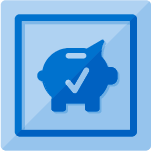Financial habits and norms
Financial habits and norms are the values, standards, routine practices, and rules to live by that people rely on to navigate their day-to-day financial lives. They support the ability to effectively manage money and respond quickly to financial decisions or challenges.
Building financial habits and norms
How are financial habits developed over time? Learn more about the financial habits and norms building block, and how values, attitudes, and beliefs about money can help young people meet their financial goals.

Importance of financial habits and norms
The skills associated with financial habits and norms allow a person to more easily make financial decisions based on their attitudes, values, emotions, social norms, and contextual cues. These skills help a person decide what’s desirable and possible financially and guide their day-to-day behaviors. This could range from decisions about splurging on a treat to how much to save in a retirement account.
Development of this building block
People typically begin to build money habits, norms, and values during middle childhood through a process called financial socialization. These habits and norms continue to develop through adolescence and influence many financial behaviors and habits in adulthood.
The tables that follow show what this building block looks like at three stages of development and how the skills and abilities relate to adult behavior associated with financial well-being.
Early childhood (ages 3–5)
| Milestones for financial habits and norms | What it may look like in adulthood |
|---|---|
Begins to develop basic values and attitudes around keeping (saving) and using (consuming) resources |
Thinks twice before buying, saves money now for an item they want later |
Middle childhood (ages 6–12)
| Milestones for financial habits and norms | What it may look like in adulthood |
|---|---|
Begins to develop a positive attitude toward planning, saving, frugality, and self-control |
Plans and saves for big purchases, spends money on needs before wants, limits splurge purchases |
Begins to show positive financial habits, like planning and saving |
Makes a financial plan (formal or informal), sets aside regular savings |
Begins to make spending and saving decisions that match personal goals and values |
Thinks about positive and negative effects of today’s purchases on future financial goals |
Feels confident about completing age-appropriate financial tasks, such as deciding how to spend allowance and depositing money in a savings account |
Pays bills on time, understands options for saving and investing, trusts ability to make good financial decisions |
Adolescence and early adulthood (ages 13–21)
| Milestones for financial habits and norms | What it may look like in adulthood |
|---|---|
Demonstrates a positive attitude toward planning, saving, frugality, and self-control |
Makes and follows a budget, saves for big purchases and for retirement |
Shows positive money management habits and decision-making strategies |
Lives within their means, compares features and costs to make an informed purchase |
Makes spending and saving decisions that match personal goals and values; resists peer pressure |
Measures financial success by own standards instead of others’, spends with values and goals for today and the future in mind |
Confidently completes age-appropriate financial tasks, such as getting a part-time job and using debit and credit cards |
Makes a financial plan, explores employment options, limits credit card use, avoids and manages debt |
Teaching this building block
School is one of many places where financial socialization occurs. Across the curriculum, classroom activities can help students practice financial behaviors and begin to develop a sense of their own money management preferences.
Instructional strategies
Research shows that the following are among the instructional strategies that can help students develop financial habits and norms.
- Blended learning: When learning is structured to include both online and in-person experiences, which can promote personalized learning and flexible pacing
- Gamification: A highly motivating learning strategy that uses game elements, mechanics, and/or game-based thinking (as opposed to playing an entire game) and requires creativity and collaboration
- Simulation: Hands-on learning activities that use real-world scenarios to promote critical thinking and application of learning
Learning activities
Learning activities that nurture financial habits and norms should promote healthy money habits, norms, rules to live by, and decision shortcuts for navigating day-to-day financial life and effective routine money management. The types of activities that support these skills include the following.
- Employment opportunities: Activities that provide a way for students to explore and prepare for job options and make clear connections between school and career
- Entrepreneurship: Opportunities for young people to create their own companies (real or imagined) and, in doing so, apply critical-thinking, innovation, communication, and collaboration skills
- Financial simulations: Educational tools or activities that replicate real-world financial management situations and allow students to develop skills such as budgeting, comparison shopping, and investing by making mock decisions that result in realistic consequences
- Understanding financial products: Activities that allow students to explore financial tools and products used to buy things, save, invest, get insurance, or get a mortgage
Resources for teaching financial habits and norms
- Search for classroom activities to nurture the development of financial habits and norms
- Explore all strategies and learning activities for nurturing the building blocks

